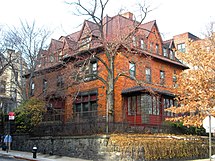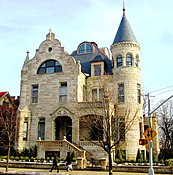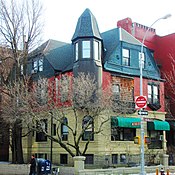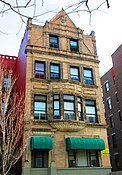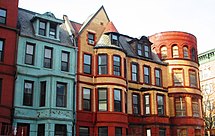Sugar Hill, Manhattan
Sugar Hill Historic District | |
neo-Grec, etc.[2] | |
| NRHP reference No. | 02000360[1] |
|---|---|
| Significant dates | |
| Added to NRHP | April 11, 2002 |
| Designated NYCL | Hamilton Heights/Sugar Hill HD: June 27, 2000 extension: October 3, 2001 Hamilton Heights/Sugar Hill Northeast HD: October 23, 2001 Hamilton Heights/Sugar Hill Northwest HD: June 18, 2002 |
Sugar Hill is a
- Hamilton Heights/Sugar Hill Historic District and Extension: roughly West 145th to West 150th Street, Edgecombe Avenue to between Convent and Amsterdam Avenues
- Hamilton Heights/Sugar Hill Northeast Historic District: roughly West 151st to West 155th Street, west of St. Nicholas Avenue to between Convent and Amsterdam Avenues
- Hamilton Heights/Sugar Hill Northwest Historic District: roughly West 151st to West 155th Street, east of St. Nicholas Avenue to Edgecombe Avenue[2][5]
The Federal district was listed on the National Register of Historic Places in 2002.[1] The Federal district has 414 contributing buildings, two contributing sites, three contributing structures, and one contributing object.[6]
History
Sugar Hill got its name in the 1920s when the neighborhood became a popular place for wealthy
Langston Hughes wrote about the relative affluence of the neighborhood in his essay "Down Under in Harlem" published in The New Republic in 1944:
Don't take it for granted that all Harlem is a slum. It isn't. There are big apartment houses up on the hill, Sugar Hill, and up by
Walter Whites, where colored families send their babies to private kindergartens and their youngsters to Ethical Culture School.[8]
Terry Mulligan's 2012 memoir Sugar Hill, Where the Sun Rose Over Harlemr[9][10] is a chronicle of the writer's experiences growing up in the 1950s and 1960s in the neighborhood, where her neighbors included future United States Supreme Court Justice Thurgood Marshall, early rock n' roll legend Frankie Lymon, and New York baseball great Willie Mays.
Notable buildings
Among the many notable buildings in the Sugar Hill area are:[2]
- Nicholas C. and Agnes Benziger House, 345 Edgecombe Avenue (William Schickel, 1890–91) - has also been used as a hospital, nursery and housing for the homeless
- Barnum & Bailey Circus
- 14 and 16 St. Nicholas Place (William Grinnell, 1883–84) - Queen Anne style detached frame houses clad in wood shingles
- Fink House, 8 St. Nicholas Place (Richard S. Rosenstock, 1885) - Queen Anne style house, would later be combined with...
- Baiter House, 6 St. Nicholas Place (Theodore G. Stein, 1893–94) - ...and used as a sanitarium, a hospital, a hotel, and a group home
- 713-721 St. Nicholas Avenue (Hugh M. Reynolds, 1890–1891) - Row houses in the Victorian Romanesque Revival style
- 718-730 St. Nicholas Avenue (Arthur Bates Jennings, 1889–1890) - A Romanesque Revival row
- 729 and 731 St. Nicholas Avenue (Theodore Minot Clark, 1886–1886) - two houses faced in Manhattan schistand shingles
- 757-775 St. Nicholas Avenue (Frederick P. Dinkelberg, 1894–1895) - A Renaissance Revival style row which is said to be "among the finest in the district."
- 409 Edgecombe Avenue Apartments (Schwartz & Gross, 1916–1817) - Originally the Colonial Parkway Apartments. Home to Babe Ruth as an infant, Aaron Douglas,[11] Thurgood Marshall, W. E. B. Du Bois,[7] and Marvel Cooke.[12]
- 555 Edgecombe Avenue. Several noted big band leaders lived here in the 1940s including Count Basie, Andy Kirk, Don Redman, Erskine Hawkins, Benny Carter and Cootie Williams.[11]
Gallery
-
Benziger House
-
14 (right) and 16 (left) St. Nicholas Place
-
Fink House
-
Baiter House
-
715 (left) - 721 (right) St. Nicholas Avenue
-
729 and 731 St. Nicholas Avenue
-
409 Edgecombe Avenue Apartments
In popular culture
- The Leslie Uggams Show featured a "Sugar Hill" sketch throughout its one-year run in 1969.[13][14]
- The Sugarhill Gang, the first rap group with a single in the Top 40, took their name from the neighborhood; the band members were actually all from Englewood, New Jersey.[15]
- The 1974 film Claudine, starring Diahann Carroll and James Earl Jones was filmed in the Sugar Hill neighborhood.[16]
- The 1994 film Sugar Hill, about drug dealers in Harlem, stars Wesley Snipes.
- Sugar Hill is mentioned in the lyrics to the jazz standard "Take the 'A' Train" by Billy Strayhorn.
- It is also referred to by rapper AZ's "Sugar Hill" on his album Doe or Die.
- Henry "Red" Allen recorded "Sugar Hill Function", written by Charlie Holmes, on February 18, 1930.
- There is also a song by Rex Stewart and his Fifty-Second Street Stompers – one of the four Duke Ellington small groups – called "Sugar Hill Shim-Sham", which was recorded on July 7, 1937.
- The 1978 film Cindy, a modern retelling of Cinderella set in Harlem, includes a scene at the Sugar Hill Ball.[17]
See also
- List of New York City Landmarks
- National Register of Historic Places listings in New York County, New York
- Bushman Steps
References
Notes
- ^ a b "National Register Information System – (#02000360)". National Register of Historic Places. National Park Service. March 13, 2009.
- ^ ISBN 978-0-470-28963-1.
- ^ "Harlem - New York City Neighborhood - NYC". nymag.com. New York (magazine). 2003-03-10. Retrieved 2009-01-04.
- ^ "Harlem, Hamilton Heights, El Barrio, New York City". ny.com. Retrieved 2009-01-04.
- ^ Siegal, Nina (2000-06-15). "Landmark Status For Harlem Buildings; District Holds Hub of Black Culture". The New York Times. Retrieved 2009-01-04.
- ^ Howe, Kathleen A. (January 2002). "National Register of Historic Places Registration: Sugar Hill Historic District". New York State Office of Parks, Recreation and Historic Preservation. Retrieved 2011-03-25. See also: "Accompanying 69 photos".
- ^ ISBN 978-0-19538-386-7.
- ^ Hughes, Langston. "Down Under in Harlem". The New Republic (March 27, 1944): 404-5
- ^ Terry Baker Mulligan website
- ^ Henderson, Jane (6 May 2012). "Penned in St. Louis: Terry Baker Mulligan". St. Louis Post-Dispatch. Retrieved 22 February 2013.
- ^ OCLC 1038016815.)
{{cite book}}: CS1 maint: location missing publisher (link - ^ Elaine Woo, "Marvel Cooke; Pioneering Black Journalist, Political Activist", Los Angeles Times, December 6, 2000.
- ^ "The Leslie Uggams Show", Academy of Television Arts & Sciences Foundation. Accessed February 15, 2024. "A major feature of the show was a continuing segment called 'Sugar Hill' about a working-class black family. Uggams played the wife of a construction worker in the sketch."
- Newspapers.com. "Perhaps the most choice item on Sunday's premiere hour is 'Sugar Hill,' the weekly adventures of a black family in a Harlem flat."
- ^ Perrone, Pierre (2011-10-04). "Sylvia Robinson: Hitmaker who co-founded Sugar Hill Records and became known as 'the mother of hip-hop' - Obituaries - News". The Independent. Archived from the original on 2022-05-25. Retrieved 2013-09-15.
- ^ "Claudine (1974) - Filming & Production - IMDb". imdb.com. Retrieved March 18, 2020.
- ^ O'Connor, John J. "TV: Harlem Setting for Cinderella", The New York Times, March 24, 1978. Accessed December 28, 2022. "With the story's setting switched to Harlem during World War II, Cinderella is transformed into an ebullient, naive country girl brought to the big city by her father.... She finally gets to go to the famous Sugar Hill Ball only with the help of Michael, who lives on a fire escape of the tenement next door."
External links
- "Hamilton Heights - West Harlem". westharlemcpo.org. Hamilton Heights - West Harlem Community Preservation Organization. Archived from the original on 2008-12-21. Retrieved 2009-01-04.

